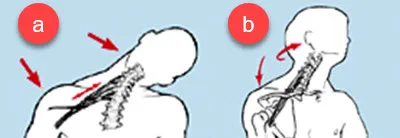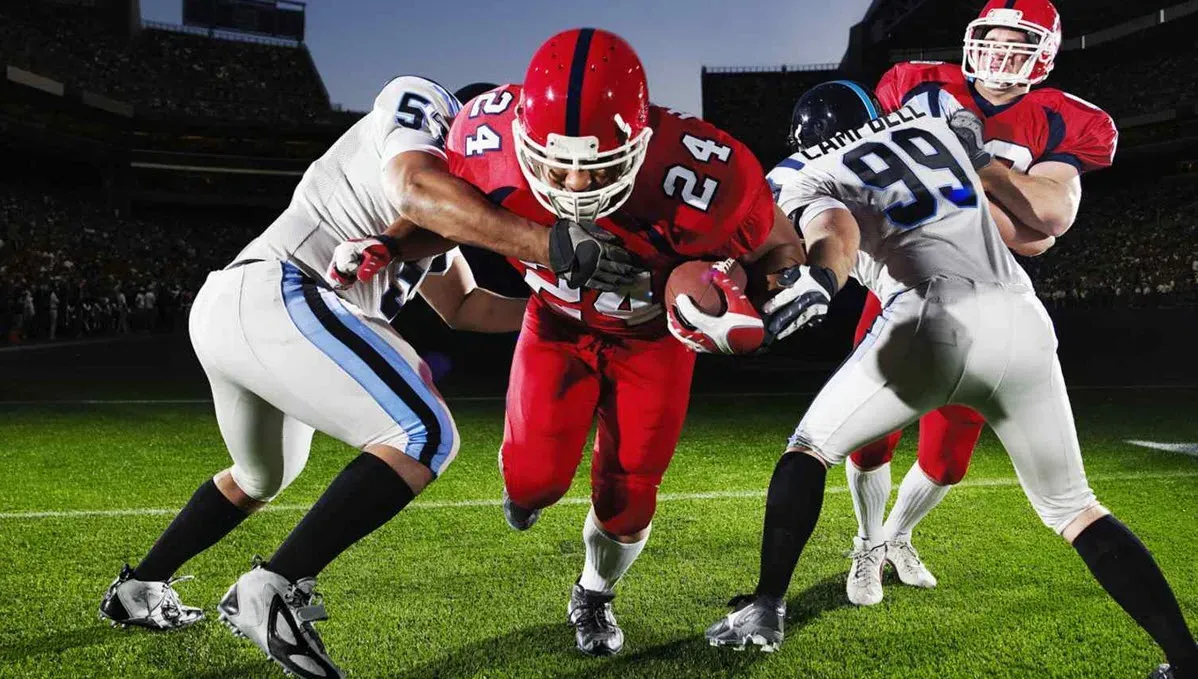Introduction
Minor brachial plexus injuries, often referred to as “burners” or “stingers”, are common incidents in the context of sporting activities, particularly those involving physical contact, such as football or rugby. These injuries typically affect the nerves of the brachial plexus, a complex network of nerves located in the neck and shoulder area.
“Burners” appear as a sudden sensation of pain, burning or tingling along the arm, usually from the elbow to the hand. These symptoms often occur after direct trauma, such as a violent impact or forced extension of the neck.
Although brachial plexus injuries are often temporary, it is crucial to take them seriously and consult a medical professional to assess their extent and rule out serious damage. In most cases, burners resolve spontaneously with proper rest and care, but more severe cases may require rehabilitation or other medical interventions.
Preventing minor brachial plexus injuries often involves adopting proper training techniques to strengthen the neck and shoulder muscles, as well as using protective equipment during high-risk activities. Increased knowledge of these injuries and their triggering factors can help minimize risks and promote safer sports practice.
These injuries generally occur during sports trauma, particularly in contact sports such as football, rugby, or wrestling. Although usually temporary, these injuries can cause severe pain and tingling sensations. Let’s take a closer look at the characteristics, symptoms, and treatment methods of these injuries.
Burners are often linked to sudden movements of the head and neck, such as those observed during a violent collision. When the head is tilted abruptly to one side, the brachial plexus nerves may be stretched or compressed, resulting in the characteristic symptoms. These incidents commonly occur among athletes playing contact sports, where impacts and collisions are common.
Symptoms of burners are usually unilateral, affecting only one arm, and can include a burning sensation down the arm, tingling, temporary muscle weakness, and sometimes numbness. The pain can be intense but is usually short-lived.
Initial treatment for burners often involves rest and the application of ice to reduce inflammation. In most cases, symptoms improve quickly. However, in persistent or recurring cases, a thorough evaluation by a healthcare professional is recommended. Rehabilitation sessions may be prescribed to strengthen the neck and shoulder muscles, reduce the risk of further injury and promote full recovery.
Preventing burners relies on proper training techniques, including strengthening neck and shoulder muscles, as well as teaching safe falling techniques to athletes. Using protective equipment, such as neck guards in contact sports, can also help reduce the risk of brachial plexus injuries.
So, although burners are usually temporary, they require proper attention and medical evaluation to rule out serious injury. A preventive approach, combining appropriate training techniques and the use of protective equipment, helps to minimize risks and promote safer sports practice.
Mechanism of Injury
- Sudden Head and Neck Movements
- Burners or stingers often occur when the head is forcefully tilted, rotated, or extended to one side during high-impact activities.
- Such movements can overstretch or compress the brachial plexus nerves, leading to a temporary disruption of nerve function.
- These injuries are common during collisions, falls, or tackles in contact sports like football or rugby.
- Traction vs. Compression Injuries
- Traction Injuries:
- Result from the stretching of the brachial plexus nerves on one side, typically when the head is pushed away from the shoulder.
- Common during tackles or falls when the shoulder is forced downward while the head tilts in the opposite direction.
- Compression Injuries:
- Occur when the brachial plexus nerves are pinched or compressed between structures in the neck or shoulder.
- Often caused by direct impact to the shoulder or neck, especially during a collision or blow to the supraclavicular region.
- Traction Injuries:
- Anatomy of the Brachial Plexus
- The brachial plexus is a complex network of nerves originating from the spinal cord in the neck (C5-T1 nerve roots).
- It extends through the neck, shoulder, and down the arm, providing motor and sensory innervation.
- Due to its location, the brachial plexus is vulnerable to injuries during sudden or forceful neck and shoulder movements.
- Its structure includes:
- Roots: Emerge from the spinal cord.
- Trunks: Combine nerve roots at the lower neck.
- Divisions: Branch into anterior and posterior sections.
- Cords: Form near the armpit, leading to peripheral nerves that control arm and hand functions.

Causes of Burners
Burners, also known as stingers, are common sports injuries affecting the nerves in the neck and shoulder region. These injuries typically occur during contact sports such as football, rugby, or wrestling, where athletes are exposed to sudden and forceful impacts. The causes of burners are multifaceted, involving a combination of anatomical factors, specific athletic maneuvers, and the nature of the sports activities.
One primary cause of burners is the abrupt stretching or compression of the brachial plexus, a network of nerves originating from the spinal cord in the neck and extending into the arms. During a high-impact collision or tackle, the head is forcefully tilted to one side, leading to the overstretching of the nerves on the opposite side. This can result in a transient disruption of nerve function, leading to the characteristic symptoms of burners, including pain, numbness, and tingling radiating down the arm.
The tackling techniques employed in contact sports contribute significantly to the occurrence of burners. A direct blow to the head or shoulder, especially when the head is turned to one side during the impact, can subject the brachial plexus to excessive tension or compression. Additionally, improper tackling form, such as leading with the crown of the helmet or making contact with the head down, increases the risk of burners. Athletes who fail to execute proper tackling techniques are more susceptible to sustaining these nerve injuries.
The nature of the sport itself plays a pivotal role in causing burners. Sports characterized by high-velocity collisions and frequent physical contact, such as American football, expose athletes to an increased risk of burners. The dynamic and unpredictable nature of these sports makes it challenging to avoid sudden impacts or collisions during gameplay. Athletes engaged in such sports are inherently more vulnerable to experiencing burners due to the intense physical demands and the potential for unanticipated contact.
Anatomical variations and individual predispositions also contribute to the causes of burners. Athletes with a narrower space between the cervical vertebrae, where the nerves of the brachial plexus exit the spinal cord, may be more prone to nerve compression during certain movements. Furthermore, pre-existing conditions, such as a history of neck injuries or abnormalities in the cervical spine, can increase an athlete’s susceptibility to burners.
- Brachial Plexus Pull: The most common mechanism of burner injury is a sudden pull of the brachial plexus. This can occur during sudden movements of the head to one side, as can occur during falls, violent contact or collisions during sporting activities.
- Direct Impact: Direct impact on the neck or shoulder region can compress the brachial plexus and result in burnout. This can happen during collisions in contact sports or accidents.
- Poor Posture: Poor posture, particularly when playing sports or physical activities, can contribute to the occurrence of burners. Poor movement technique can increase the risk of brachial plexus injury.
- Excessive Stretching: Excessive stretching of the neck and shoulders, often associated with rapid, unexpected movements, can cause compression or traction of the brachial plexus.
- Contact Sports: Burners are frequently associated with contact sports such as football, rugby, hockey and American football, where collisions and physical contact are common.
- Falls: Falls with impact on the neck or shoulder area can cause burns, particularly if the head is tilted to the side at the time of impact.
- Individual Anatomy: Certain individuals may be more predisposed to burners due to their anatomy. Anatomical variation can make the brachial plexus more vulnerable to compression or traction.
Symptoms of Burners
Burners or stingers are temporary nerve injuries that typically occur in the neck and shoulders, often associated with contact sports or sudden head movements. Symptoms of burners can vary in intensity and duration, but generally include the following:
- Burning Sensation: The main characteristic of a burner is an intense burning sensation that spreads down the arm. This feeling may be sudden and last from a few moments to a few minutes.
- Electric or Stinging Pain: Affected individuals may feel electrical pain, tingling, or stinging sensations along the affected nerve.
- Muscle Weakness: Temporary weakness of the muscles of the affected arm may occur, making it difficult to lift or move the arm.
- Numbness: Numbness may occur, leading to decreased sensitivity or tingling in the affected area.
- Loss of Muscle Control: In some cases, there may be a temporary loss of muscle control, affecting coordination of movement.
- Sensitivity to Touch: The affected area may become sensitive to touch, with an increased reaction to pressure or contact.
- Temporary Reduction in Mobility: Due to weakness and altered sensation, there may be a temporary reduction in mobility of the affected arm.
- Unilateral Symptoms: Burners are usually unilateral, affecting only one side of the body, often the right or left arm.
Diagnosis of Burners
- Clinical Evaluation and History
- A thorough clinical evaluation is essential for diagnosing burners or stingers.
- Key components:
- Patient History: Inquiry about recent trauma or activities, such as high-impact collisions or sudden neck movements during sports.
- Symptom Description: Assessment of the burning or tingling sensation, muscle weakness, numbness, or pain radiating down one arm.
- Physical Examination:
- Palpation of the neck and shoulder to identify areas of tenderness or swelling.
- Strength testing of the arm muscles to evaluate potential weakness.
- Range of motion assessment of the neck and shoulder to detect any restrictions or pain during movement.
- Sensory testing to check for numbness or altered sensation along the affected nerve distribution.
- Differentiation from Other Nerve or Neck Injuries
- Burners must be distinguished from other conditions that may present with similar symptoms, including:
- Cervical Radiculopathy: Nerve compression at the cervical spine level due to herniated discs or bone spurs.
- Cervical Spine Fractures: Trauma to the vertebrae, often accompanied by severe neck pain and instability.
- Shoulder Injuries: Conditions like rotator cuff tears or shoulder dislocations may mimic burner symptoms but lack the characteristic nerve pain.
- Peripheral Nerve Entrapments: Conditions like carpal tunnel syndrome or ulnar nerve entrapment can cause tingling and weakness in the arm but are unrelated to the brachial plexus.
- Clinical tests, such as Spurling’s maneuver, can help differentiate cervical nerve root compression from a brachial plexus injury.
- Burners must be distinguished from other conditions that may present with similar symptoms, including:
- Importance of Imaging in Persistent Cases
- Although most burners resolve spontaneously, persistent or recurring symptoms warrant further evaluation.
- Imaging Studies:
- X-Rays: Used to rule out cervical spine fractures or alignment issues.
- Magnetic Resonance Imaging (MRI): Provides detailed visualization of soft tissues, including nerves, discs, and ligaments, to identify potential nerve root compression or brachial plexus injuries.
- Electromyography (EMG): May be used to assess nerve conduction and muscle activity, helping to determine the extent of nerve damage.
- CT Myelography: In rare cases, may be utilized to identify spinal cord or nerve root injuries.
- Imaging is especially important when symptoms persist for weeks, worsen over time, or are accompanied by neck instability, bilateral symptoms, or signs of severe nerve dysfunction.
Treatment of Burners
- Rest and Ice: Rest is essential to allow the brachial plexus to recover. Applying ice for the first few hours can help reduce inflammation.
- Painkillers: Nonsteroidal anti-inflammatory drugs (NSAIDs) such as ibuprofen may be used to relieve pain and reduce inflammation.
- Rehabilitation: Once pain has subsided, rehabilitation exercises may be recommended to strengthen the neck and shoulder muscles and improve stability.
- Prevention: To prevent recurrent injuries, proper warm-up techniques, strengthening exercises and sports technique adjustments may be suggested.
- Medical Consultation: In the event of persistent symptoms, it is essential to consult a healthcare professional to assess the severity of the injury and exclude any more serious injury.
Although burners are generally considered minor injuries, any brachial plexus injury requires proper attention to avoid long-term complications. In case of doubt or persistent symptoms, it is recommended to consult a healthcare professional for an accurate diagnosis and a suitable treatment plan.
Rehabilitation and Prevention
- Strengthening Neck and Shoulder Muscles
- Building strength in the neck and shoulder muscles provides better support to the brachial plexus, reducing the risk of future injuries.
- Rehabilitation Exercises:
- Isometric Neck Exercises: Pushing the head gently against resistance in all directions to strengthen neck stabilizers.
- Shoulder Stabilization Exercises: Focused on the rotator cuff and scapular muscles using resistance bands or light weights.
- Postural Strengthening: Exercises like chin tucks and wall angels to improve alignment and reduce stress on the neck and shoulders.
- Proper Sports Techniques and Warm-Ups
- Athletes should be educated on the importance of maintaining proper technique during contact sports to avoid undue strain on the brachial plexus.
- Key Components:
- Learning safe tackling and blocking techniques in football or rugby to minimize head and neck tilting.
- Proper grip and stance in sports such as wrestling or judo to prevent overextension of the neck.
- Incorporating dynamic warm-ups that include neck rolls, shoulder stretches, and light cardio to increase flexibility and prepare muscles for activity.
- Protective Equipment for Contact Sports
- Wearing properly fitted protective gear can significantly reduce the risk of burners in high-impact sports.
- Examples:
- Neck Collars or Roll Devices: Help limit excessive neck movement and provide additional stability.
- Shoulder Pads: Ensure adequate coverage and protection of the brachial plexus area during impacts.
- Helmet Fitting: A correctly fitted helmet reduces the risk of excessive head movement during collisions.
- Adjustments to Posture and Movement Mechanics
- Correcting posture and optimizing movement mechanics decreases unnecessary strain on the brachial plexus during sports and daily activities.
- Postural Adjustments:
- Maintaining a neutral head position during physical activity to avoid excessive lateral or backward tilting.
- Avoiding slouched shoulders or forward head posture, which can increase tension in the neck.
- Biomechanical Assessments:
- Evaluating an athlete’s movement patterns to identify and correct faulty mechanics that may predispose them to injury.
- Implementing ergonomic changes in training and gameplay, such as repositioning during tackling or blocking to minimize brachial plexus tension.
Prognosis and Recurrence
- Recovery Timeline for Mild Cases
- Most mild cases of burners, also known as stingers, resolve quickly, often within a few minutes to several hours.
- Symptoms such as burning pain, tingling, or weakness typically subside once the nerve irritation diminishes.
- For more moderate cases, recovery may take several days to a week, especially if associated with muscle weakness or soreness.
- Persistent symptoms lasting beyond two weeks should prompt further evaluation by a healthcare professional to rule out more significant nerve or structural damage.
- Managing Recurrent Symptoms
- Recurrent burners may indicate unresolved biomechanical issues, inadequate recovery, or underlying structural vulnerabilities.
- Management Strategies:
- Physical Therapy: Focused on neck and shoulder strengthening, improving flexibility, and addressing muscle imbalances.
- Postural Adjustments: Ensuring proper alignment during daily activities and sports to reduce strain on the brachial plexus.
- Activity Modification: Reducing exposure to high-risk movements or positions that provoke symptoms.
- Medical Evaluation: Persistent or recurring burners should be assessed for conditions such as cervical spine abnormalities or chronic nerve compression.
- Long-Term Strategies to Prevent Re-Injury
- Preventative Strengthening Programs:
- Regularly incorporating exercises that enhance neck and shoulder stability, such as resistance training, scapular control exercises, and dynamic neck movements.
- Safe Sports Practices:
- Emphasizing proper techniques in tackling, blocking, or falling to minimize high-risk impacts.
- Encouraging adequate warm-up routines before physical activity, focusing on dynamic stretches for the neck and shoulders.
- Protective Equipment:
- Consistent use of well-fitted helmets, shoulder pads, and neck rolls in contact sports to limit excessive movement and protect the brachial plexus.
- Regular Monitoring:
- Periodic assessments by sports medicine or orthopedic professionals for athletes with a history of recurrent burners.
- Monitoring for any new symptoms or changes in physical condition that could predispose to re-injury.
- Preventative Strengthening Programs:
Conclusion
In summary, burners or stingers are temporary nerve injuries often resulting from sudden movements or impacts to the head, neck, or shoulder, common in contact sports. These injuries typically affect the brachial plexus, leading to symptoms such as burning pain, tingling, and muscle weakness in the arm. While most cases resolve quickly, recurrent or persistent symptoms warrant further evaluation to rule out serious injuries.
Early intervention is essential for effective recovery. Rest, ice application, and appropriate rehabilitation exercises can help restore function and prevent complications. Strengthening neck and shoulder muscles, adopting proper sports techniques, and using protective equipment are key strategies for reducing the risk of recurrence.
Finally, individuals experiencing burners should not dismiss the condition as minor. Seeking professional advice ensures accurate diagnosis, appropriate treatment, and guidance on long-term prevention, fostering safer sports participation and overall musculoskeletal health.
References
- Prentice, W. E. (2017). Principles of Athletic Training: A Guide to Evidence-Based Clinical Practice (16th Edition). McGraw-Hill Education.
- A comprehensive guide covering sports-related injuries, including brachial plexus injuries, their prevention, and rehabilitation strategies.
- Brukner, P., & Khan, K. (2017). Brukner & Khan’s Clinical Sports Medicine (5th Edition). McGraw-Hill Education.
- Key reference for understanding sports injuries and rehabilitation techniques, including stingers and nerve injuries.
- Torg, J. S., & Ramsey-Emrhein, J. A. (1997). Cervical cord neurapraxia and stenosis. Clinical Sports Medicine, 16(2), 303–318.
- A detailed review of cervical spine injuries, including nerve injuries like burners and their management.
- Anderson, M. W., & Read, J. W. (2007). Stingers, burners, and transient brachial plexopathies. American Journal of Sports Medicine, 35(4), 607–616.
- A research article exploring the mechanisms, diagnosis, and treatment of transient brachial plexus injuries.
- Wilkerson, G. B. (1990). Biomechanical and neural correlates of stinger risk in football. Journal of Athletic Training, 25(2), 96–101.
- Examines risk factors for stingers in football and offers insights into prevention through biomechanical analysis.
- Feinberg, J. H. (2010). The brachial plexus and brachial plexopathy. Muscle & Nerve, 41(4), 498–519.
- Provides a detailed overview of brachial plexus anatomy and pathologies, including sports-related injuries.
- Marar, M., McIlvain, N. M., Fields, S. K., & Comstock, R. D. (2012). Epidemiology of concussions among United States high school athletes in 20 sports. American Journal of Sports Medicine, 40(4), 747–755.
- Discusses the prevalence of neck and brachial plexus injuries in youth sports.
- Côté, P., Hogg-Johnson, S., Cassidy, J. D., Carroll, L. J., & Frank, J. W. (2001). The burden and determinants of neck pain in workers. European Spine Journal, 10(6), 444–454.
- Explores occupational and biomechanical factors contributing to neck and shoulder injuries.
- National Athletic Trainers’ Association (NATA). (2009). Position statement: Management of cervical spine injuries. Journal of Athletic Training, 44(3), 306–331.
- A guideline on managing cervical and brachial plexus injuries in sports settings.
- American Academy of Orthopaedic Surgeons (AAOS). (2023). Burners and Stingers.
- A patient-centered guide explaining burners, their symptoms, and management strategies. Available at: AAOS website.
- Torg, J. S., & Truex, R. C. (1977). Cervical spine injuries to the brachial plexus. The Journal of Bone and Joint Surgery, 59(1), 85–92.
- Early foundational study on cervical spine and brachial plexus injuries in athletes.





















